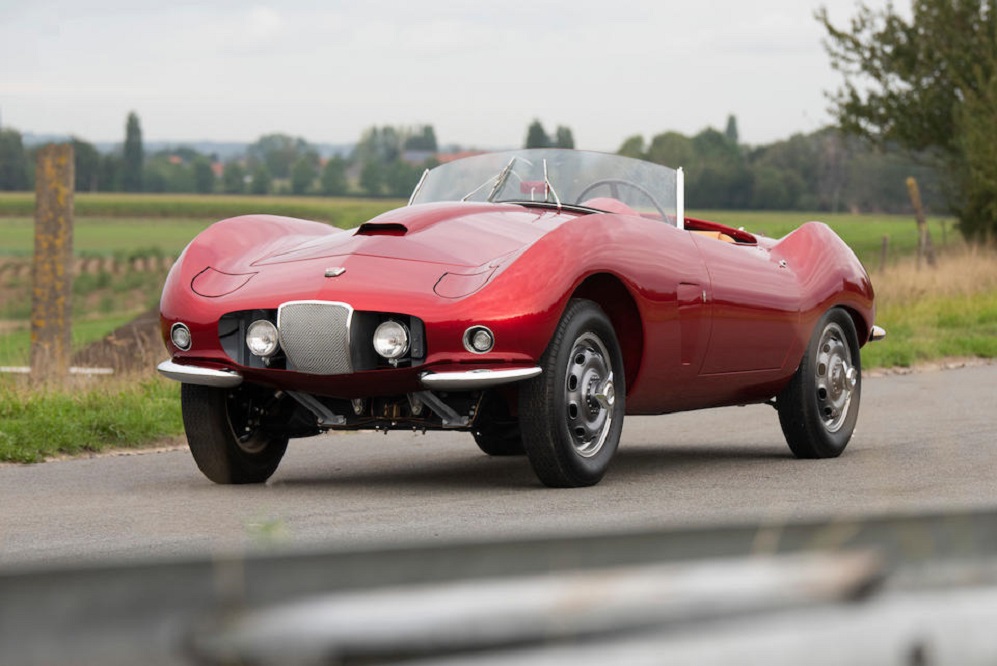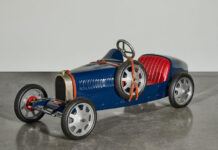Stanley “Wacky” Arnolt from Warsaw, Indiana, was one of the many American self-made entrepreneurs, but he was also a petrolhead at heart. Upon leaving university in 1930 with a degree in science, he joined the Waukesha engine factory and quickly moved up the company ladder. When Waukesha went bust due to the effects of the Great Depression, he shrewdly bought the patent of their four cylinder marine engine. And as soon as WWII started, Stanley went to Washington DC and got the contract to power the US Navy small crafts with his engine.

Chassis no. 404X3119
•One-off Arnolt-Bristol with factory hardtop
•Three owners from new
•Candy Red metallic over red-piped beige leather interior from new
•Not seen in public since the 1956 Arnolt Chicago warehouse fire
•Completely restored to concours standard
•Mille Miglia eligible
That huge military business made him very wealthy. At the end of the war, he decided to fulfil his long ambition to build his own branded car company and established the S.H. Arnolt Incorporated in Chicago. Wacky quickly saw the desire for the newly wealthy American middle class to acquire exotic automobiles as a status symbol for racing. In 1950, he started a distribution of European cars, mostly British brands such as Aston Martin, Bentley, MG and Bristol. Back to 1952 Turin, to the astonishment of Nuccio Bertone who was used to making only small production runs or one-offs, Arnolt ordered 200 units of the MG Bertone, thus starting the affordable British Sports Car with Italian coachwork. In the process that order started the Italian Carrozzeria’s postwar fortunes. On the stand, Stanley also noticed an extraordinary creation from the newly hired Bertone head designer, a certain Franco Scaglione. That automobile was the talk of the show, the now famous Fiat-Abarth 1500 Biposto, so much so that American company Packard bought it to be an inspiration for their own design studio. Arnolt’s timely intervention effectively saved Bertone from bankruptcy!
The Abarth was the first masterpiece of Franco Scaglione, whose future creations would become milestones of automobile design: the Alfa Romeo B.A.T.’s, Giulietta Sprint, Sprint Speciale, 2000 Sportiva, 33 Stradale, the Porsche Abarth 356 GTL just to name a few… When MG moved to a new chassis after circa 100 units were sent to Bertone and refused to continue production of the TD rolling chassis, Stanley decided to use the same recipe but based on the new Bristol 404 chassis and powered by the legendary BMW designed inline-6 developing a stout 130 bhp. He promptly negotiated with the Bristol Company the purchase of 200 rolling chassis to be sent to Bertone. Giovanna, the daughter of Franco Scaglione recalls that Stanley Arnolt fell in love with the Abarth Biposto, and specifically asked for Scaglione to design a stylish roadster based on the Bristol chassis. The work would be very difficult because the engine had carburettors placed on top of it and required a tall hood line. Yet, the master of Aerodynamics came up with a very clever solution: a scoop for the carburettors would allow for the lowering of the hood below it and the raised fenders with sharp edge would visually distract the eye with their voluptuous lines. A simple grill flanked by two big headlights would hide most of the air intake opening. At the rear, the same curvaceous fender design would continue, ending with two simple round taillights. Minimalistic design, yet sensual and very aerodynamic. Tests with wool threads on the Italian Autostrada would prove the basic goodness of Scaglione design and the first prototype was shown at the London Motor Show late October 1953.
Three open models were offered ranging from the basic competition version (minimum fittings, minimal perspex screen instead of a windshield and leatherette seating) via the better-appointed Bolide (with side windows and a real windshield) to the fully equipped Deluxe (came with a bespoke cockpit with full instruments, leather seats, windshield wipers, winding side windows, a soft top and quarter bumper). There was also an enclosed coupé. Arnolt charged $3,995 for the competition model, $4,245 for the Bolide, $4,995 for the Deluxe, and $5,995 for the coupé.

The Bristol engine could be tuned to produce in excess of 150bhp, and before long the pretty Arnolts were making their mark in production sports car races in the USA. After class wins at Sebring and Le Mans in 1955, the works team was disbanded following the fatal accident that claimed the life of driver Bob Goldich, returning to Sebring in 1960 to capture class and team awards yet again. The recipe for the car’s racing success was due to its extreme lightness at 2,100 pounds, a rigid chassis with perfect weight distribution, a very slippery body devoid of turbulence and the power and reliability of the BMW-engineered engine.
Arnolt-Bristol production ceased in 1963 after a total of around 140 cars had been sold, Bertone having had to devote most of its productive capacity to the new Alfa Romeo Giulietta Sprint. Twelve Arnolt-Bristols were destroyed in a fire at the factory.
Chassis number ‘404X3119’ is unique because it was intended to be built as a coupé and then had its “roof cut off” by Arnolt to transform it into a roadster with a detachable hardtop. It is the only Arnolt Bristol to undergo this conversion and has kept the coupé’s distinctive retractable headlights. According to historians, Stanley Arnolt wanted to showcase a special “European orientated” luxury automobile for the 1956 Paris Motor Show. The car was painted in custom Candy Red metallic with a gold base coat, exactly like Bertone’s Jaguar XK150 show car, while the luxurious interior was trimmed in beige Connolly leather with red piping, pop-up head lights, chrome bumpers and central gas tank. With these unique features, ‘3119’ was designed to be more luxurious than the Deluxe, and Stanley Arnolt wanted to sell it for $6,000, like the coupé, instead of the Deluxe roadster list price of $5,000.
After the Paris Motor Show, ‘3119’ was shipped to the Arnolt Company in the USA. It had the latest-specification BS1 MKII engine, number ‘324’. Upon arrival in the USA, the car was sent to the main Chicago showroom adjacent to the warehouse where the aforementioned fire destroyed 12 cars on 12th December 1956. Fortunately, ‘3119’, being in the adjacent showroom, was damaged but not beyond repair. After the fire, the body and remaining parts were salvaged from the showroom (minus the engine, that had been removed and disappeared meanwhile) and sold to Dick Braund, a friend of Stanley Arnolt. In 1987 these components were acquired by Dave Knaack, who stored them in his warehouse.
Many years later, in 2013, Lieven Goeman, a prominent Arnolt-Bristol collector, purchased ‘3119’ from Dave Knaack. Having owned some unique Arnolt Bristols, Mr Goeman immediately recognised the car’s uniqueness and decided to restore it back to 1956 Paris Motor Show specification. The restoration to concours standard took more than six years to complete, such was the difficulty in finding genuine Arnolt Bristol parts for the rebuild. Every part of the car was returned to ‘as new’ condition with the finest attention to detail, and the coupé/roadster even received the very rare (fewer than five sets known) Borrani bi-metal wheels, which Mr Goeman had collected over the years. Since the original engine was lost in the Chicago fire, it has been replaced with one of the same BS1 MKII specification (number ‘258’), again fully revised and in as new condition having benefitted from just some very few shakedown kilometres after the car’s full restoration as can also be seen in the engine bay, which looks ‘as new’.
Finished in its original colour scheme of Candy Red metallic with red-piped beige leather interior, this ultra-rare, American-inspired, Anglo-Italian sports car is worthy of a place in any important private collection. The ‘hardtop’ coupe is eligible for most prestigious events including the Mille Miglia and world-class concours events like Pebble Beach Concours, where it was invited for the 2020 edition.
Report by bonhams.com










